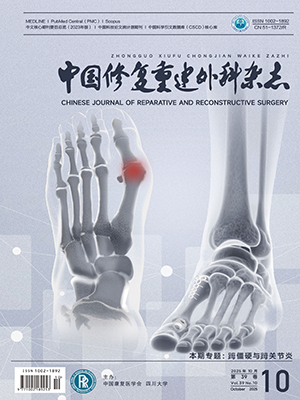| 1. |
陳明光. AO 可塑形雙鋼板置入內固定修復老年肱骨遠端骨折: 效果的影響因素分析. 中國組織工程研究, 2015, 19(31): 5016-5020.
|
| 2. |
劉士偉. 雙側鎖定鋼板內固定術治療肱骨遠端骨折臨床分析. 河南外科學雜志, 2016, 22(2): 101-102.
|
| 3. |
趙同生, 劉國慶, 楊烈東, 等. 肱骨遠端骨折雙鋼板固定技術臨床研究. 中國傷殘醫學, 2017, 25(5): 54-55.
|
| 4. |
龔平, 劉平靜. 雙鋼板內固定治療成人肱骨遠端骨折患者的療效觀察. 醫療裝備, 2017, 30(6): 150-151.
|
| 5. |
祁蓓, 胡兵. 肱骨遠端骨折術后運動康復臨床療效觀察. 深圳中西醫結合雜志, 2017, 27(3): 90-91.
|
| 6. |
謝剛泰. 肘關節骨折術后的早期康復治療. 醫藥前沿, 2017, 7(7): 394.
|
| 7. |
陳朝清. 早期運動康復對肘關節骨折后功能恢復的影響. 中國傷殘醫學, 2016, 24(14): 60-61.
|
| 8. |
沈彥, 王朝陽, 吳興旺, 等. 不同術式治療成人 C 型肱骨遠端骨折. 臨床骨科雜志, 2015, 18(4): 504-505.
|
| 9. |
孫銘. 經伸肌裝置保護入路切開復位內固定治療肱骨遠端 C 型骨折的功能效果. 鄭州大學學報(醫學版), 2013, 48(5): 704-706.
|
| 10. |
郭永智, 戴鶴玲, 趙建文, 等. 三種內固定技術治療肱骨遠端 C 型骨折的療效比較. 中華創傷雜志, 2013, 29(5): 395-400.
|
| 11. |
溫干軍, 江帝欽, 陳堅, 等. 三角固定技術治療肱骨遠端 AO-C 型骨折的臨床療效. 生物骨科材料與臨床研究, 2017, 14(1): 46-50.
|
| 12. |
高云, 張治宇. 兩種術式治療肱骨遠端骨折遠期效果觀察. 臨床軍醫雜志, 2017, 45(3): 292-294.
|
| 13. |
龍安華, 韓大成, 胡國東, 等. 兩種方法治療成人肱骨遠端骨折的回顧性隊列研究. 北京醫學, 2017, 39(2): 193-195.
|
| 14. |
廖春雨. 肱骨遠端 C 型骨折的治療進展研究. 醫學信息, 2017, 30(2): 30-31.
|
| 15. |
萬新河. 成人肱骨遠端關節內骨折手術治療體會. 醫藥前沿, 2017, 7(3): 171-172.
|
| 16. |
付樂良, 吳志雄, 李青. 兩種內固定方法治療肱骨髁間 C 型骨折效果觀察. 中外醫學研究, 2017, 15(3): 145-147.
|
| 17. |
Montserrat-de la Paz S, García-Giménez MD, ángel-Martín M, et al. Long-chain fatty alcohols from evening primrose oil inhibit the inflammatory response in murine peritoneal macrophages. J Ethnopharmacol, 2014, 151(1): 131-136.
|
| 18. |
Chen KH, Chiu HY, Lee JW, et al. Using the proximal perforator-based anterolateral thigh flap from the same donor site to salvage the reconstruction after failure of the distal perforator-based anterolateral thigh flap. Microsurgery, 2014, 34(5): 409-412.
|
| 19. |
Park M S, Yoon S J, Choi S M. Arthroscopic reduction and internal fixation of femoral head fractures[J]. J Orthop Trauma, 2014, 28(7): e164-168.
|
| 20. |
廖亮華, 江興妹, 葉志衛, 等. 早期康復對肘關節骨折術后功能恢復的影響. 中國康復理論與實踐, 2010, 16(9): 867-869.
|
| 21. |
Unsworth-White J, Koka R, Churchill M, et al. The non-operative management of radial head fractures: a randomized trial of three treatments. Injury, 1994, 25(3): 165-167.
|




